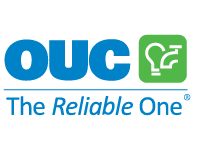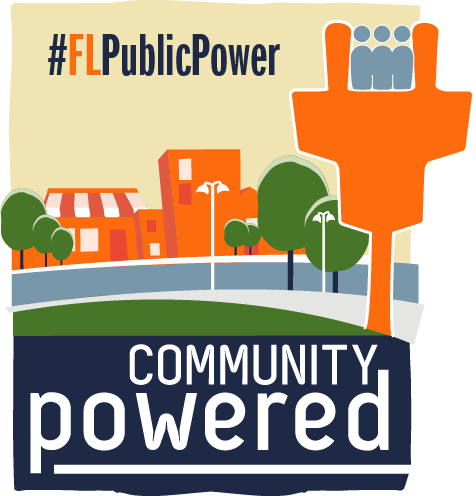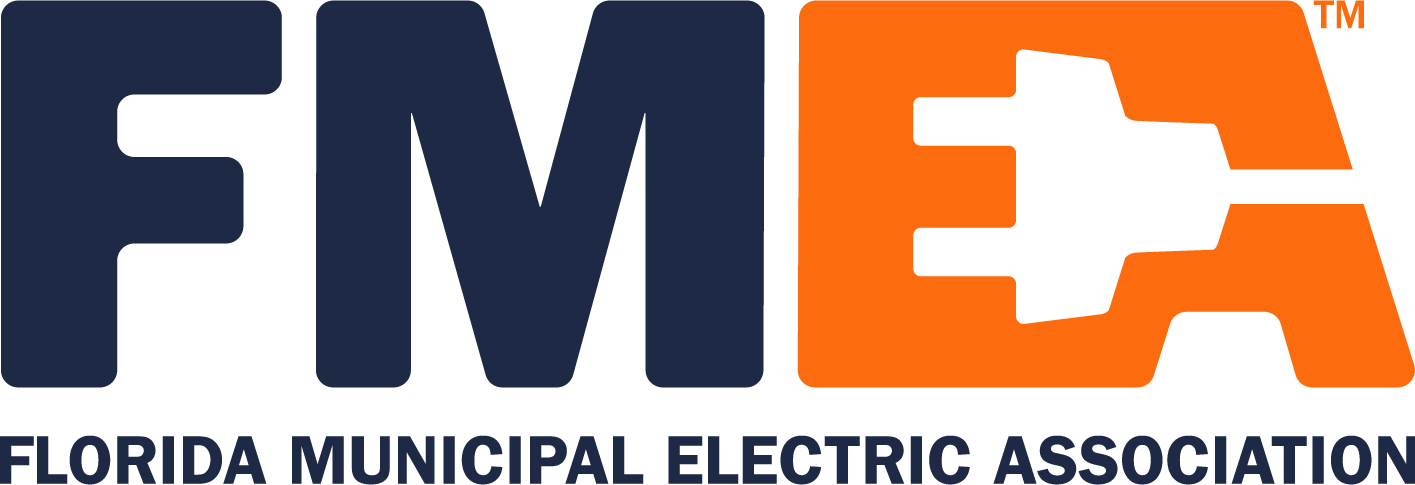City Honors OUC for a Century of Reliability
 Orlando Mayor Buddy Dyer proclaims June 26 as ‘OUC 100th Anniversary Day’
Orlando Mayor Buddy Dyer proclaims June 26 as ‘OUC 100th Anniversary Day’
Earlier today, Monday, 6/26, the Orlando Utilities Commission (OUC—The Reliable One) was honored for a century of reliable service to Central Florida with a proclamation declaring "OUC 100th Anniversary Day." The announcement was made by Orlando Mayor Buddy Dyer at City Hall.
OUC traces its roots to a group of companies that provided electricity to illuminate downtown streetlights and delivered water and ice to the community. In 1923, the Florida Legislature established the Orlando Utilities Commission after Judge John M. Cheney, owner of Orlando Water and Light Company, Orlando’s first power and water plants, proposed that a municipal utility own and operate the facilities and that bonds be issued to allow the citizens of Orlando to purchase the utility and turn them over to the newly formed OUC to provide electricity and water service.
Thus, OUC was founded as a municipal utility commission with a mission to provide reliable and affordable electric and water services to the residents and businesses of the City of Orlando. The utility's first board meeting was held on June 25, 1923, at First National Bank in Orlando.
From serving 2,795 customers in 1923 to more than a quarter of a million customers today, OUC, now the 14th largest municipal utility in the nation and the 2nd largest in the state, has played an integral role in supporting the growth of Central Florida by investing in cutting-edge energy generation and water delivery innovations, all while meeting the community's demand for quality and accessibility.
“Since the day OUC was founded, we have innovated and evolved to meet the needs of our customers and our community, and we will never stray from our commitment to exceed our customers’ expectations,” said Clint Bullock, General Manager & CEO. “Our dedicated employees, those who came before us and those who are here today, make that commitment possible. We are well-positioned to meet the future needs and expectations of the community, and we remain dedicated to being a partner of choice and a leader of innovative solutions.”
"In Orlando, we are fortunate to have a municipal-owned utility that is truly part of our community and has always been focused on serving residents and businesses to ensure that Orlando is a great place to live, do business and visit," said Orlando Mayor Buddy Dyer. "I am proud of our partnership with OUC to make The City Beautiful one of the most sustainable cities in the country and improve the quality of life of our residents."
Throughout its history, OUC has achieved numerous milestones, many of which demonstrate its commitment to the community, innovation and environmental stewardship. Here are a few noteworthy examples:
- In 1924, the Lake Ivanhoe Water Plant was placed into service. Water from the plant and electricity from the power plant on Lake Highland were used to make ice for an onsite ice plant with an ice-making capacity of 60 tons per day. Ice was sold locally, shipped to neighboring towns and used to cool railroad cars and trucks that shipped fruit and produce.
- In 1936, OUC moved its headquarters to a building at the corner of Wall and Main Streets. Martin Brown, the utility’s first chief engineer, was named General Manager.
- During World War II, OUC donated the third floor of its office to the American Red Cross, which set up a surgical training center there.
- In 1955, OUC lineworkers erected an illuminated Christmas star above South Orange Avenue, starting a tradition that marks the start of the holiday season.
- In 1957, OUC moved from surface water to well water drawn from the Floridan Aquifer. This allowed plants to be located strategically throughout the city and interconnected by distribution pipes to serve a growing population. OUC now operates seven water plants.
- In 1957, OUC presented the City of Orlando with what became known as the Lake Eola fountain. The city landmark was originally called the Centennial Fountain and later renamed the Linton E. Allen Memorial Fountain in honor of the president of First National Bank (now Truist) and community leader.
- In 1960, OUC commissioned the Indian River Plant in Brevard County. At a cost of $16 million at the time, the oil- and gas-fired power plant was the largest project OUC had undertaken.
- In 1968, the Florida State Board of Health chose OUC’s water department as the best large-city operation in the state for the three previous years.
- In 1977, OUC made its first investment in zero-emission nuclear power, buying a 1.6% interest in the Crystal River 3 Nuclear Plant. Three years later, OUC bought a 6% interest in a nuclear plant that was under construction.
- In 1980, OUC set in motion plans to build the Curtis H. Stanton Energy Center in what was then the rural, uninhabited pine woods of east Orlando. Additionally, OUC paved the dirt road that led to the site, which today is known as Alafaya Trail. The facility was designed to meet the Orlando area’s growing energy needs for the foreseeable future, and it went into commercial operation in 1987. SEC’s energy portfolio is the most diverse in the state, using coal, gas, landfill methane gas and solar to generate electricity.
- In 1993, OUC tested an electric vehicle (EV) outfitted with solar panels on its roof. The trial marked OUC’s early interest in EVs, which are now included in its fleet.
- In 1997, OUC began serving the City of St. Cloud.
- In 1997, OUC opened its first chilled water plant, leading to an expansion of a new service, OUCooling. Today, OUC operates seven chilled water districts across Orlando.
- In 2004, three hurricanes battered the Orlando area over a 45-day period. Charley knocked out power to 80% of OUC’s customer; Frances, 40%; and Jeanne, 59%. OUC responded to the storm damage, replacing 570 poles, 453 transformers, 26.6 miles of primary line and 44.2 miles of second line.
- In 2008, OUC's new customer and administrative office, Reliable Plaza, was recognized as the "Greenest Building in Downtown Orlando," receiving the Leadership in Energy and Environmental Design's (LEED) highest certification of Gold.
- In 2009, OUC and Orange County flipped the switch on a 1-megawatt solar array at the Orange County Convention Center.
- In 2017, OUC is the first utility in the state to operate a floating solar array. The innovation remains afloat on a pond at OUC’s Gardenia Innovation & Operations Center.
- In 2020, OUC became the first utility in the state to set goals for reducing CO2 emissions. OUC announced plans to achieve net zero CO2 emissions by 2050, with interim CO2 emissions reductions of 50% by 2030 and 75% by 2040. The plan includes increasing the use of renewable and clean energy resources, with solar power generation expected to reach 272 megawatts by 2024. Also in 2020, OUC’s board approved a $12.1 million customer aid package in response to the economic hardships created by the COVID-19 pandemic.
- In 2020 and 2022, OUC was recognized as a “Most Trusted Brand” among U.S. energy providers, as determined by a national customer survey conducted by the human behavior and analytics firm Escalent. In both years, OUC earned the highest score among U.S. electric utilities.
- In 2021, OUC was named the nation’s highest-ranked midsize water utility in J.D. Power’s annual water utility residential customer satisfaction study.
- In 2022, OUC broke ground on the first net-zero corporate campus to be built for a Florida utility. The St. Cloud Operations & Maintenance Center incorporates state-of-the-art technology and sustainability practices. Phase 1 construction is set to be completed in December 2023.
- In 2023, OUC opens one of the largest electric vehicle (EV) charging stations in Florida. Located in downtown Orlando, the Robinson Recharge Mobility Hub features 20 high-speed chargers. OUC also secured a grant to develop a second site for high-speed EV charging in Orlando. These EV charging hubs are part of OUC's $45 million investment to promote transportation electrification.
 Enter your email address in the
Enter your email address in the 